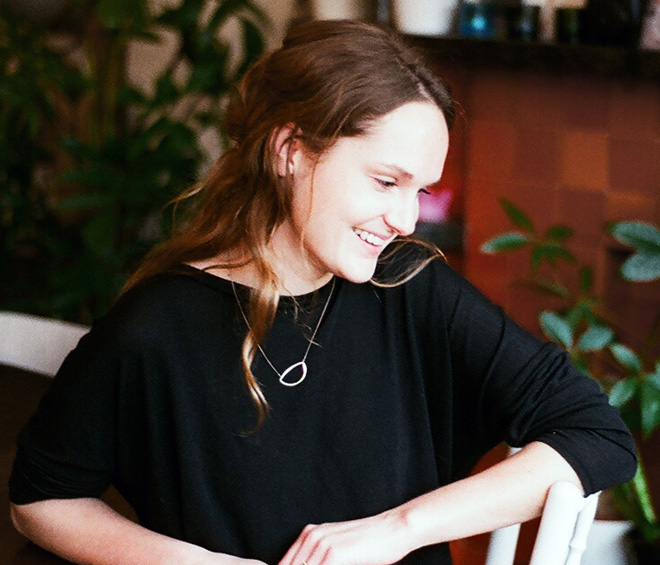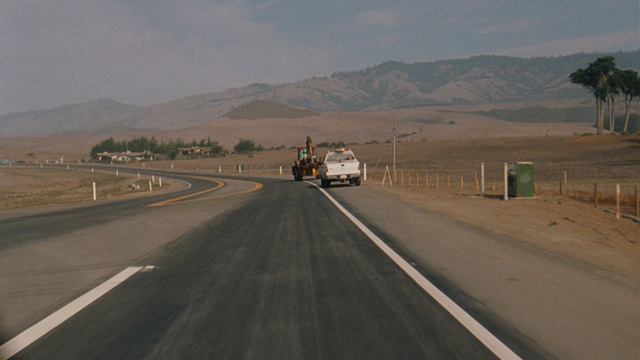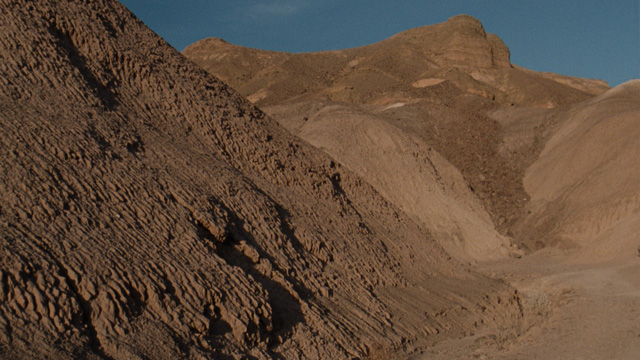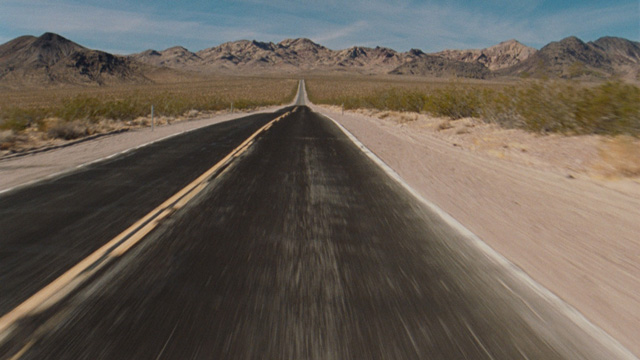
Eva van Tongeren. © the artist.
by IZABELLA SCOTT
Eva van Tongeren (b1990) is a Dutch filmmaker who studied at the LUCA School of Arts in Belgium. Her short film Still From Afar (2018) grew out of correspondence with a man called Thomas, a convicted paedophile, who is serving eight years in prison in Belgium. The film combines serene shots of deserts, trees and rivers with a voiceover that muses on what it means to write to, and collaborate with, a paedophile.
I saw Van Tongeren’s film at the International Film Festival in Rotterdam, where it premiered at the Kino cinema. I have an interest in artworks that take crimes as their subject, and we later caught up to speak of prison letters, ethics, and the problem of disguising crime with beauty.
Izabella Scott: How did you come to begin writing to Thomas?
Eva van Tongeren: I approached this in a very naive way. When I was studying film at the LUCA School of Arts in 2015, I came across an organisation called Traliepost, which roughly translates as “prison letters”. It connects people in jail with those outside, to try to prevent loneliness and isolation in prisoners. I thought it might be interesting to open a correspondence; I like to read and write, and felt I rarely had the opportunity to meet people outside my social bubble. So, I signed up. In the first letter I received from Thomas, he told me in detail why he was in prison, and about his love for a young girl. It was only then that I began to realise the gravity of the endeavour.

Eva van Tongeren, Still from afar, 2018. Film, 18 mins. © the artist.
IS: Was there a particular reason the organisation paired you up with Thomas, or is the process fairly random?
EVT: The matching process is not random, but quite complex. The organisation asked me to fill out a form, which has lots of questions about things you like doing, work, hobbies, and other personal details. You can also say if you’d prefer to write to a woman or a man, and if you have any preferences around religion or age. I was really open, I had no conditions. In my first letter, I knew almost nothing about Thomas. I introduced myself in quite a simple way, saying that I liked books and films. Later, I inferred that the organisation matched us because of our joint love of film. Thomas collected films: before he went to prison, he had a collection of more than 100 DVDs.
IS: On that form you mentioned, can you rule out certain crimes? Can you say: “I don’t want to speak to somebody who has done X or Y?”
EVT: No. It’s also not always the case that the crime is disclosed. The organisation says that it depends on whether or not the inmate wants to talk about their crime. It’s their choice. Some inmates might never bring it up, and the fact that Thomas spoke about his crime right away is a little unusual. Indeed, somebody from the organisation called me before I received the letter. In the first few exchanges, they read the letters to make sure everything is going smoothly, and so they informed me that I’d be receiving a very detailed letter. It meant that I was prepared; I waited a few days to open it and took time to read it. I also waited a little before answering, by which time I had read the letter several times.
IS: So, in this first letter, Thomas tells you he is a paedophile. How did you respond?
EVT: Thomas spoke openly about his criminal desires. And I have to admit, although the content was very, very heavy, it was also written so beautifully that I felt as if I was reading a novel. This happened often in our correspondence. And when Thomas writes about his crime so beautifully, the crime is disguised by beauty. This makes it easier to read about, and it is also, of course, very dangerous. Sometimes, I feel as if he is seducing me with beautiful words, as he tries to make me understand how he feels, and why he had done what he has done.
IS: The film emerged from these letters, but also from the images you began to send Thomas in prison, images that he asked you for. Why did you want to keep writing to him, to begin what is ostensibly a collaboration?
EVT: I kept writing to him – indeed, four years on, Thomas and I are still in touch. I have questioned myself often: why do I keep writing? At first, the main topic of our letters was his crime, but over time, he we shared a lot of other information. I discovered he was not much older than I am. He also told me about his dreams of owning a house, of marrying somebody his age. He thought that having a family would solve his problems. Strangely, his dreams were not so dissimilar to my own, and I suppose this made him easier to relate to. So, I kept writing. It was my suggestion to send him images, as I thought it would give us something else to speak about, beyond his crime, his loneliness and his attraction to young girls.

Eva van Tongeren, Still from afar, 2018. Film, 18 mins. © the artist.
IS: Are these some of the image we see in the film – desert landscapes, rivers and forests?
EVT: No. It began with snapshots I took with my iPhone, images I took quickly and printed quickly. I’m always taking photographs, archiving things that I see and that I want to get a grip on. Sometimes there are images that Thomas specifically requested; at other times, things I just saw and thought were beautiful. To give you an example: in one of our letters, Thomas asked me to photograph a cruise ship, so I went to the harbour, and found a boat. He told me that he wanted to get married on a cruise ship. It appealed to him, this idea of taking all your guests on a boat, out to sea, to get married on the water. He thought it was so chic. So, I sent him a picture. Another time he asked me for a picture of the beach. It took him a while to ask, and he explained that, at first, he was afraid to ask me, because he thought I would suspect that he was trying to get hold of a picture of children on the beach. But what he wanted was an empty beach: sand, sun and sea. On other occasions, I gave him pictures of things that I found strange and beautiful, such as a dying cricket that I saw on the street, or a bird in a tree. Then we spoke of making a film together.
IS: A number of ethical questions loom over the film, which are inevitable when you make an artwork with a crime at its centre. Were you thinking about the victim, and how she might feel to see this crime become an artwork? And were you ever worried that, like Thomas, your film could disguise crime with beauty?
EVT: This question is at the heart of the film. Thomas is complicit in the making it, and in some ways, he became a collaborator. At one point, I printed the film, frame by frame, and delivered it to him as a stack of sheets, because I was only allowed to send paper into the prison. Thomas commented on the voiceover, and took part in the edit and, in this way, I’ve never had to worry about his representation. Perhaps the bigger question, then, is in regard to victims of the crime Thomas has committed. Every time I show the film, I consider the fact that there may be someone in the audience who has suffered child abuse. This is really difficult – I don’t think there is any way around this, except to be really clear about what the film is about. In the journey of making this film, I spoke a lot with organisations about child abuse, including Centrum voor Daderhulp in Brussels and Vertrouwenscentrum Kindermishandeling in Antwerp, and to victims of child abuse. As time went on, I wanted more context, and I read in all directions: books written by paedophiles, books written by victims, literature such as Vladimir Nabokov’s Lolita. It was important for me to have all these different perspectives. I collaborated with Thomas, but the film is not about Thomas so much as about me, as an artist, trying to understand a person who has committed this crime, and trying to discover if there is any way to relate to them.

Eva van Tongeren, Still from afar, 2018. Film, 18 mins. © the artist.
IS: When I think of Thomas receiving in his cell these images of things he cannot see, it’s hard not to think of your pictures as gifts of some sort. Thomas is in prison serving time for a terrible crime. Did you ever wonder whether he deserved this gift you gave to him?
EVT: The film is addressed to the spectator, and I don’t think of it as a gift to Thomas. But the pictures I sent along the way – I can see how you might perceive them as a gift. During our correspondence, I felt it was important to change the conversation. Thomas wrote about his crimes, his desire for young girls, his own self-hate. We were trapped in a very negative spiral. It was through sending pictures that we were able to talk about other things. Along the way, even as I knew the details of Thomas’s crimes, I feel empathy for him, and that is what the film seeks to understand, and give words to. I learned from his letters that inmates convicted of child abuse are hated by all other prisoners; they are at the bottom of the hierarchy of crimes. Thomas rarely left his cell. He didn’t go outside at exercise time, because he was afraid of getting attacked, which is very common for prisoners who have committed his crime. So, he was inside his cell most of the time, with no perspective, no friends or family who visited him. I felt that we had to talk about other things, aside from his crime. And it helped to write about things that I’ve experienced, and then to send him images. It is, indeed, a gesture. Does he deserve this gift? I really don’t know.

Eva van Tongeren, Still from afar, 2018. Film, 18 mins. © the artist.
IS: The images in the film were shot in California – a road trip though Zabriskie Point, Lone Pine, Sequoia, Cambria and Los Angeles. Then images are then overlaid with dialogue from your letters. Why these images?
EVT: One thing that often came up in my letters with Thomas was that dreamy question: ‘If you were able to travel anywhere in the world, where would you go?’ Thomas talked about China and America, and indeed the American dream came up several times. Later, when we decided to make a film, it seemed obvious to travel to the US. I’d never been there before – it was never my dream. Thomas loved westerns and he has always dreamed of going to the desert and to the redwoods. I began to think more and more of landscapes, and how this might be a good way to approach the film: images that Thomas was not able to see. I obtained finance from the Flanders Audiovisual Fund to travel to America for two weeks. By this point, I was thinking so specifically about the film and the audience, and my outlook was very different from when I took the iPhone snapshots for only Thomas to see. The question at the centre of the film is: how to interact with somebody who has committed a crime like this. It’s very difficult to understand or integrate a person like this into society. I hoped the landscape shots would open up space for the audience to think about this question.
IS: Most societies have zero tolerance for paedophiles – for good reason. At the same time, images of young girls proliferate in the media, in fashion and pop music, and society might be more complicit than it thinks in the eroticisation of young girls – or at least, less innocent than it might believe. This doesn’t reduce the crime of paedophilia in any way, but it adds another context.
EVT: I thought a lot about how paedophiles are represented in the media. They are solely defined by their crime, portrayed as monsters. And this is true – this crime is awful, perhaps unforgivable. But in making this film, I wanted to give the audience space to reflect on this subject. Nuance is important, too – we always need more nuance. And the nuance is this: the Thomases of this world have committed a heinous crime. But they are also more than only their crimes.